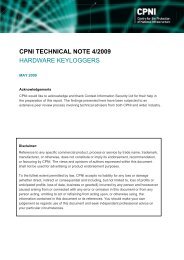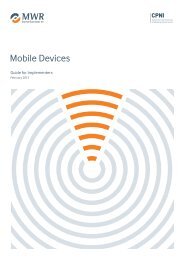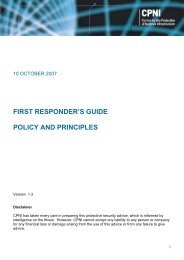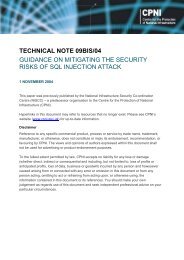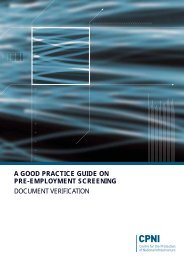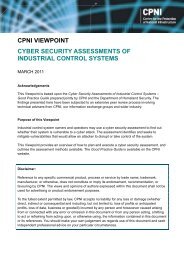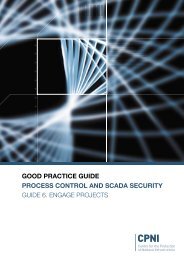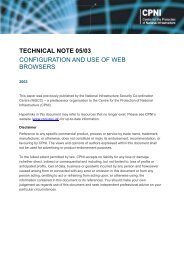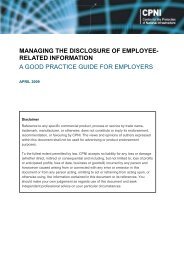Border gateway protocol filtering guidelines - CPNI
Border gateway protocol filtering guidelines - CPNI
Border gateway protocol filtering guidelines - CPNI
You also want an ePaper? Increase the reach of your titles
YUMPU automatically turns print PDFs into web optimized ePapers that Google loves.
ANNEX C:Other suggestions for improving BGP security – under discussion in thecommunity.1. [12] MD5 password strength & management issues. There are a variety ofrecommendations for best practice in MD5 use. It is certainly true that MD5cracking tools are available in the hacker community. Currently, most providerstake the pragmatic view that MD5 implementation (with well-chosen, nondictionary-based passwords) enhances security, even where some details of theimplementation could be further improved.2. Egress <strong>filtering</strong>. Ideally, <strong>filtering</strong> should be both on ingress & egress. Providersshould encourage their customers to perform egress <strong>filtering</strong>, according to these<strong>guidelines</strong>. Outbound route <strong>filtering</strong> can provide an alternative to customer egress<strong>filtering</strong>.3. [14] BGP TTLH (time to live hack) also known as BTSH (BGP Time-to-livesecurity Hack) – suggests that routers set TTL to be 255, and only accept BGPpackets with TTL 254, as the peer is always exactly 1 hop away. This introducesextra difficulty for an attacker, compared to the default of expecting the TTL to be1. TTLH/BTSH is principally designed to protect against DOS attacks floodingport 179. This is not widely implemented (Juniper JUNOS implements thisfeature).4. Filtering of incoming BGP packets on entry, before passing to the CPU, canalso protect the router from Dos via port 179. Implementation is not even acrossvendors, feedback from providers on which implementations are most successfulwould be welcome.5. [11] [9] Graceful restart. A facility where a router preserves its forwardingstate through a restart (time-limited to e.g. 30 seconds), so eliminating the needfor peers to “flap” all its routes. Implemented by Juniper, Cisco (as Cisco non-stopforwarding) & Riverstone, among others. Several providers (US) suggest that thecost of implementing this feature outweighs the benefit.6. [18] Sink-holes to protect customer networks. The ability to set these up inresponse to an event/attack is highly desirable, and will provide a valuable serviceto CNI providers in non-communications sectors.7. AS-Path <strong>filtering</strong>. In addition to prefix <strong>filtering</strong>, some providers recommendusing AS-Path <strong>filtering</strong>, to drop any announcements with private AS numbers inthe AS path, and setting a max-as-path-length.8. [13] Use of BGP MED values has been suggested as a means to enhancesecurity, however, this can have a variety of effects. Accepting MED values fromPeers may introduce a (small) extra risk.9. [15] S-BGP aims to set up a PKI authentication scheme to authenticate BGPpeering & announcements. Lack of backward compatibility with BGPv4 is aproblem.10. [16, 17] soBGP. Developed by Cisco. Aims to use PKI to authenticate theorigin of BGP packets, but not the peering connections. Security increasesproportionally with adoption, but it is compatible with non-secure BGPv4.




